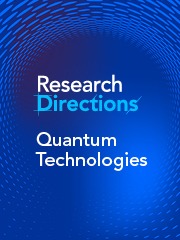Context
Quantum computing advantage emerges not from brute force power, but from subtle differences in information processing that can occur for key bottleneck subroutines. In 2019, the Google Quantum AI team performed a landmark experiment demonstrating quantum computational supremacy (Arute et al., Reference Arute, Arya, Babbush, Bacon, Bardin, Barends, Biswas, Boixo, Brandao and Buell2019) where they performed a quantum computation that, at the time, could not be done on a classical supercomputer. This was remarkable because it was achieved by a processor with only 53 qubits, an observation that emerged from theoretical work which identified that quantum computers could have a massive advantage for certain specially designed benchmarking tasks (Boixo et al., Reference Boixo, Isakov, Smelyanskiy, Babbush, Ding, Jiang, Bremner, Martinis and Neven2018; Bremner et al., Reference Bremner, Montanaro and Shepherd2016).
Unfortunately, for real-world commercially relevant applications, the best-case estimates for a quantum advantage typically range in the millions to billions of qubits (Gidney and Ekera, Reference Gidney and Ekera2021; Webber et al., Reference Webber, Elfving, Weidt and Hensinger2022; Babbush et al., Reference Babbush, Gidney, Berry, Wiebe, McClean, Paler, Fowler and Neven2018) achievable within wildly varying timeframes from 5 to 30+ years. As quantum processors are still in their infancy, quantum application development and performance benchmarking cannot be modelled through a robust prototyping and application development framework in the same way as is done in traditional computing. Instead, we must more heavily rely on theoretical analysis and software tools to project where a quantum advantage might be found.
In this question, we would like to consider what are the next-generation tools to accelerate this process. The development of robust use cases for quantum applications that can predict accurate timeframes and costs for deployment requires cross-disciplinary research across three areas:
-
(1) Algorithmic design and discovery;
-
(2) Optimisation and resource benchmarking; and
-
(3) Hardware level optimisation, implementation, and proof-of-concept development.
In most domains, this involves identifying where quantum computers might provide an advantage, a careful accounting of the resources required in a problem instance, and an evaluation of anticipated hardware requirements (Paler et al., Reference Paler, Herr and Devitt2019).
The discovery of the future scientific and/or commercial capabilities to be unlocked by quantum technologies is far from a solved problem. This question aims to bring together decades of experience within the quantum theory, algorithms, error correction, resource optimisation communities and subject matter experts to help develop new techniques, tools, software and hardware capabilities to identify how best to utilise quantum technologies.
How to contribute to this Question
If you believe you can contribute to answering this Question with your research outputs find out how to submit in the Instructions for authors (https://www.cambridge.org/core/journals/research-directions-quantum-technologies/information/author-instructions/preparing-your-materials). This journal publishes Results, Analyses, Impact papers and additional content such as preprints and “grey literature”. Questions will be closed when the editors agree that enough has been published to answer the Question so before submitting, check if this is still an active Question. If it is closed, another relevant Question may be currently open, so do review all the open Questions in your field. For any further queries, check the information pages (https://www.cambridge.org/core/journals/research-directions-quantum-technologies/information/about-this-journal) or contact this email (quantumtechnologies@cambridge.org).
Competing interests
The author(s) declare none.




